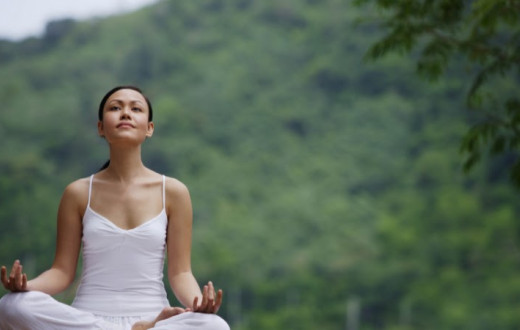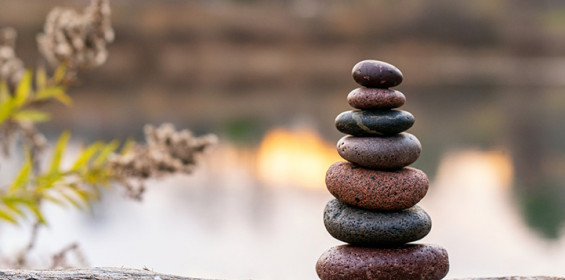By Sejal Shah
Yoga is a powerful antidote to stress. Here are the top 15 yoga poses for stress relief. Give them a try now and find the much-needed relaxation.
For the majority of us, life can be stressful. At one point or another, many of us will have experienced that sense of being overwhelmed, as if everything were just too much and beyond our capacity to manage. This sense of overwhelmedness, known as stress, can have serious repercussions on our health, especially if it lasts longer.
What is stress?
Stress can be defined as the degree to which you feel overwhelmed or unable to cope as a result of unmanageable pressures.
Stress can mean different things to different people. What causes stress to one person could be of little concern to someone else. Some people can handle stress better than others.
How does stress affect you?
We are naturally equipped to handle small doses of stress. But, we are not equipped to handle long-term, chronic stress. When we do, we experience physical, mental, or behavioral consequences: fatigue, lack of focus and clarity, and emotional exhaustion.
Stress can affect all aspects of your life, including your emotions, behaviors, thinking ability, and physical health, and the expression of stress can vary from person to person.
How to manage your stress?
Stress is a natural part of everyone’s life. Each one of us may have a different reason to feel stressed and a unique way to deal with it; some healthy ways, some not so healthy ways. While some of us prefer to sweat it out with exercise, others might prefer a comparatively relaxing approach like yoga, breathwork, meditation, mudra (yogic hand gestures).
How yoga helps stress release; some scientific studies
A yoga routine helps to regulate the breath and relax the body by gently releasing tension from the large muscle groups, flushing all parts of the body and brain with fresh blood, oxygen, and other nutrients, and increasing feelings of well-being.
Yoga’s breathing practices and meditation help to access an inner strength that aids practitioners face the overwhelming fears, frustrations, and challenges of everyday life.
Yoga improves the secretion of GABA (Anti-anxiety) Neurotransmitters. Yoga is linked with greater improvement in mood and anxiety, and increased levels of GABA, than a metabolically matched walking exercise.
Yoga impacts serotonin balance. Yoga and Meditation help the body release serotonin naturally. Yoga asanas can directly increase the firing rates of serotonin neurons, resulting in the increased production and release of serotonin. Meditation also has a direct impact on the brain’s production of serotonin levels.
Yoga reduces the Cortisol (Stress) Hormone. Yoga practice inhibits the posterior area of the hypothalamus (the sympathetic area that activates fight and flight response), leading to reduced production of ACTH from the pituitary gland and cortisol from the adrenals. Yoga moderates the production of the cortisol hormone thus reducing the stress level of a person and keeping the individual calm.
Yoga helps release endorphins: Like most forms of exercise, yoga can boost your body’s production of hormones such as endorphins which are essential to cultivating happiness, health, and feelings of calmness. They also play an important role in managing physical pain and negative emotions.
15 yoga poses to get started on your journey of stress relief and prevention
The following yoga asanas (yoga poses) and breathing practices can help achieve a happy and healthy mind and body, in addition to many other benefits. You can do them individually or make a little sequence out of them! Listen to your body, to make yourself more comfortable with the postures, you may also use props like straps, bolsters, blocks. When done on a regular basis, these will not only help you relieve stress but also build your resilience against it.
1. Full yogic breath
How to do: Place your right hand on your navel, left on your chest. Breathe deeply, expanding your belly, chest, shoulders, gradually filling the entire lungs, and exhale completely emptying lungs. Repeat 5-10 times.
How it helps: Centers the mind, brings you to the present moment.
2. Gentle Neck Rolls
How to do: Sit or stand comfortably with your spine nice and tall. Breathing in, take your head up and back, breathing out, chin to the chest. Breathing in, gently rotate your head from right to up, breathing out, from left to forward and down. Repeat 3 times and then reverse, from left to right.
How it helps: When done gently with soft breaths quickly releases tension from the neck and head
3. Cat Stretch (Marjariasana)
How to do: Come on to palms, knees, and toes. Hands shoulder-width apart, knees hip-width apart, heels parallel. Breathing in, look forward, arching the back towards the floor. Breathing out, chin to chest, arch back towards the ceiling. Repeat 4-5 times and relax.
How it helps: Relieves stress and calms the mind. Creates emotional balance.
4. Child’s Pose (Shishuasana)
How to do: Sit on the heels, keeping hips on heels, and bend forward, placing the forehead on the floor. Rest with gentle breaths.
How it helps: Calms the brain and helps relieve stress and fatigue.
5. Downward Facing Dog (Adhomukha Shwanasana)
How to do: Come onto all fours (table pose). Breathing out, lift hips, straightening knees and elbows forming an inverted V-shape with the body. Hands are shoulder-width apart, and feet are hip-width apart and parallel to each other. Hold. Take gentle breaths. Exhale. Bend the knees, and return to table pose. Relax into the child’s pose.
How it helps: Calms the mind and strengthens the body.
6. Standing Forward Bend (Hastapadasana)
How to do: Breathe in, extending arms overhead. Breathe out, folding forward and down towards toes. Hold. Breathe in, stretch arms forward and up, come up to a standing position. Breathe out, bring arms to sides.
How it helps: Quiets the mind.
7. Tree Pose (Vrikshasana)
How to do: Stand tall and in Mountain Pose (Tadasana). Keeping your left leg firm on the mat, bend your right knee and place your right foot firmly high up on your left thigh. Once you feel steady, take a deep breath in and bring your palms together in ‘Namaste’ mudra at your chest or overhead. Look straight in front of you and gently focus your gaze on an unmoving object. Hold the pose for 5-10 breaths. On a slow exhalation, gently bring your hands down to your sides. Relax your right leg. Repeat on the opposite side.
How it helps: Helps you feel grounded and focused.
8. One-Legged Seated Forward Bend (Janu Sirsasana)
How to do: Sit tall with legs stretched out in front. Bend the left knee and place the left foot inside the right thigh. Inhale, raising both arms above head, stretch up. Exhale, stretching forward from your hip joints and keeping the spine straight, directing your chin towards your toes. If possible, hold the big toes. Hold. Keep breathing. Inhale, come up. Exhaling, bring arms down to sides. Repeat on the other side.
How it helps: Calms the mind, helps relieve mild depression, anxiety, headache, fatigue.
9. Two-Legged Seated Forward Bend (Paschimottanasana)
How to do: Sit tall with the legs stretched out and toes flexed. Inhale, raising both arms above head, stretching up. Exhale, bending forward from the hip. Keep the spine erect, moving toward your toes rather than towards your knees. Place the hands on the legs, wherever they reach. Stretch the arms out in front. Inhale, and come back up to the sitting position. Exhale and lower arms.
How it helps: Calms the mind, helps relieve mild depression, anxiety, headache, fatigue.
10. Bridge Pose (Setubandhasana)
How to do: Lie on your back, bend knees while keeping your feet on the floor, hip-distance apart. Inhaling raise the thighs, pelvis, and gradually whole back, bringing chest to chin. Stay there, exhaling, lower the back to the floor and relax.
How it helps: Releases stress and tension from the lower back.
11. Shoulder Stand (Sarvangasana)
How to do: Lying on the back, lift the legs up. Let your legs go overhead, and supporting the back, bring the legs perpendicular to the floor. Let the legs be in line with the back. Hold. Slowly take the legs overhead, then lower the back and relax.
How it helps: Helps improve blood circulation to the head, energizes the nervous system.
12. Fish Pose (Matsyasana)
How to do: Lying on your back, bring your hands under your back, and lift your head and chest up, bending your neck backward to put the crown of the head on the floor, pushing the chest up. Stay for a few seconds. Slowly release your head onto the floor and relax.
How it helps: Relieves tension in the upper body, neck, and shoulders.
13. Bow Pose (Dhanurasana)
How to do: Lie on your abdomen, bend your knees and hold the ankles. Breathing in, lift the chest off the ground, and pull your legs up and back. Hold. Breathing out, gently bring the legs and chest to the ground. Release the ankles. Relax.
How it helps: Good stress and fatigue buster, opens up the chest, neck, and shoulders
14. Corpse Pose (Savasana)
How to do: Lie flat on your back with your eyes closed, and legs about two feet apart, toes falling outward. Place arms alongside and little away from body palm open facing upward. Breath easily, gently, and keep resting for a few minutes. You may also do a few minutes of Yoga Nidra to give your mind and body a few minutes of thorough relaxation.
How it helps: Provides a deep, meditative rest, allowing for the repair of tissues and cells, relaxes your nervous system. Leaves you feeling rejuvenated.
15. Alternate nostril breathing (Nadishodhan pranayama)
How to do: Sit tall with your eyes closed. Left hand in chin mudra (thumb and pointer finger gently touching, rest of finger straight, palm facing up) on your left knee. The first two fingers of the right hand on the forehead between eyebrows, with the right thumb, gently close the right nostril. Breath out gently and fully through the left nostril, then softly breath in. With the last two fingers of the right hand, close the left nostril. Open right, slowly exhale, and then Inhale, close right. Open left, gently exhale to finish the first round. Do 9 rounds or 5 minutes.
How it helps: Feel calm and relaxed.
Top up with SKY Breath Meditation
A 2019 study at Yale University evaluated the impact of three well-being programs on undergraduate students: SKY Breath Meditation, Mindfulness-Based Stress Reduction, and Emotional Intelligence, compared to a control group. Of all the programs, SKY Breath Meditation had the most benefits—reducing stress and depression, enhancing mental health, social connection, mindfulness, and positive emotions.
Using the SKY (Sudarshan Kriya) Breath Meditation (also recommended by New York Times bestselling author James Nestor in his book BREATH), you will become more resilient and have the best tool in your toolkit to manage any kind of stress in your life.
Join Beyond Breath: A Safe Way to Stress Relief, a free online class where you will get a first-hand experience of a powerful breathing technique and enjoy a calming guided meditation with a live instructor. You will also get the opportunity to interact with the instructor, learn more about SKY, and find out what this life-transforming meditation practice can do for you.
You are all now set to combat stress in your life and lead a happy, peaceful life.
Give a try these yoga poses today to destress. Do share with us which yoga pose you tried and how it helped you.
Also, if you know your near and dear one who’s battling with day-to-day stress, help them by sharing this blog post. Help them find inner peace!
Sejal Shah, E-RYT 500 Sri Sri Yoga Teacher, YACEP, C-IAYT, Meditation Teacher, SKY Instructor, NYU Post Graduate Medical School approved Yoga-CME retreat facilitator, Mind-Body Wellness Writer, Homeopath. She can be followed on YouTube, Instagram, Twitter, and Facebook.




























